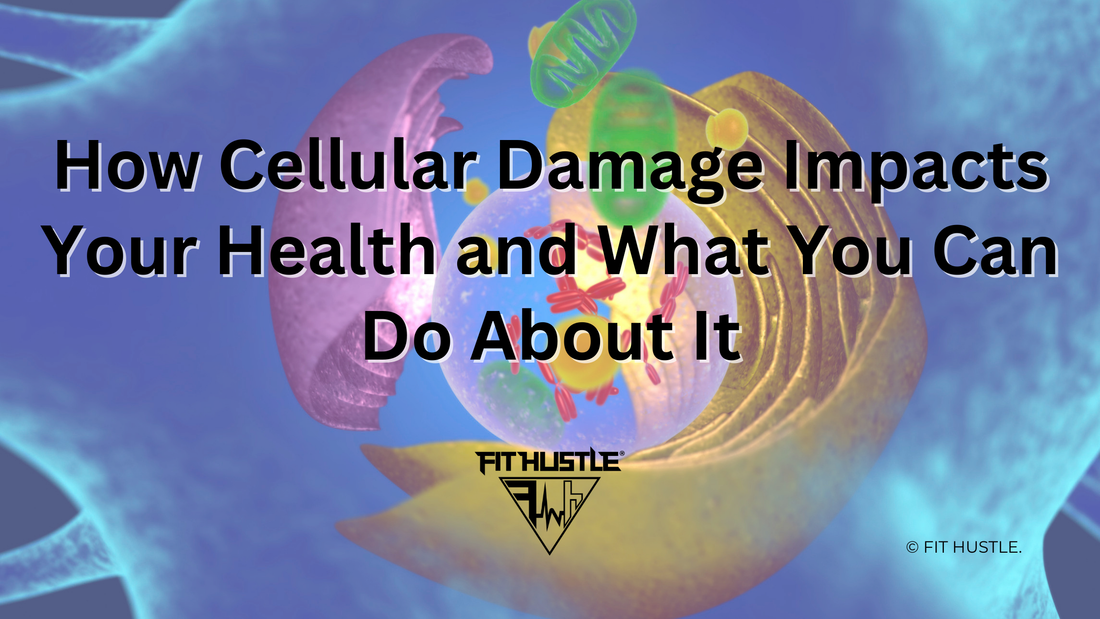
How Cellular Damage Impacts Your Health and What You Can Do About It
Share
How Cellular Damage Impacts Your Health and What You Can Do About It
We all strive to live our best lives, achieving peak performance in our daily activities. But did you know that at the very foundation of our health lies a microscopic world of cellular activity? Our cells are constantly working, battling stress, and repairing damage. This blog post explores the concept of cellular damage response and cellular dysfunction, explaining how these processes impact your overall health and well-being.
What is Cellular Damage Response?
Imagine your cells as tiny factories working tirelessly to keep your body functioning. Every day, these factories encounter various stressors, including:
- Free radicals: These unstable molecules can damage cell structures and DNA (1).
- Environmental toxins: Pollution, chemicals, and radiation can all contribute to cellular damage (2).
- Inflammation: Chronic inflammation creates a hostile environment for cells, leading to damage (3).
- Aging: As we age, our cells become less efficient at repairing damage (4).
When faced with these challenges, cells activate a defense mechanism known as the cellular damage response.
This intricate process involves a series of steps aimed at:
- Identifying and repairing damaged components: Cells have specialized mechanisms to detect and fix damaged DNA, proteins, and organelles (5).
- Activating protective mechanisms: Cells can trigger inflammation to isolate the damage, activate antioxidants to neutralize free radicals, and even initiate programmed cell death (apoptosis) to eliminate severely damaged cells (6).
The cellular damage response is a remarkable defense system, but it's not invincible. When cells are repeatedly exposed to stressors or when repair mechanisms become compromised, they can enter a state of cellular dysfunction.
This means the cells are no longer functioning optimally, leading to:
- Reduced energy production: Damaged mitochondria, the powerhouses of the cell, can compromise energy production, leading to fatigue and decreased performance (7).
- Impaired communication: Cellular dysfunction can disrupt communication pathways within the body, contributing to chronic diseases like diabetes and heart disease (8).
-
Accelerated aging: Persistent cellular damage can accelerate the aging process, leading to premature aging and age-related diseases (9).
Optimize Your Hustle: Protecting Your Cells
Understanding the cellular damage response and dysfunction is crucial for optimizing your hustle and achieving peak health.
Here are some practical steps you can take:
- Eat a healthy diet: Focus on nutrient-rich foods, including fruits, vegetables, and whole grains, to provide your cells with the building blocks they need for repair (10).
- Manage stress: Chronic stress can overwhelm the cellular damage response. Practice stress-reducing techniques like exercise, meditation, and deep breathing (11).
- Get enough sleep: Sleep is essential for cellular repair and regeneration. Aim for 7-8 hours of quality sleep each night (12).
- Stay active: Regular exercise helps improve cellular function, boost blood flow, and reduce inflammation (13).
- Limit exposure to toxins: Minimize exposure to pollutants, chemicals, and excessive sunlight (14).
Conclusion
Our cells are the foundation of our health and well-being. By understanding the cellular damage response and cellular dysfunction, we can make informed choices to protect our cells and optimize our performance. Remember, your hustle starts at the cellular level. By prioritizing cellular health, you're investing in your long-term well-being and maximizing your potential.
- OPTIMIZE YOUR HUSTLE™ - A SERIES BROUGHT TO YOU BY FIT HUSTLE™
This blog post is for informational purposes only and should not be construed as medical advice. The information provided is not intended to diagnose, treat, cure, or prevent any disease or health condition. Always consult with a qualified healthcare professional before making any decisions related to your health or treatment.
References
1. Free radicals and antioxidants in disease: a critical evaluation. Halliwell, B. Annals of the New York Academy of Sciences. 1991;639:1-14.
2. Environmental toxins and human health: a review. Bingham, E., et al. Environmental Health Perspectives. 2001;109(1):1-12.
3. Inflammation and chronic diseases. Coussens, L.M., et al. Nature. 2002;420(6917):860-866.
4. Cellular senescence and aging: a tale of two clocks. Campisi, J. Cell. 2013;154(6):1049-1057.
5. DNA repair and human health. Friedberg, E.C., et al. Nature Reviews Molecular Cell Biology. 2006;7(1):9-18.
6. The role of apoptosis in health and disease. Thompson, C.B. Science. 1995;267(5197):1456-1462.
7. Mitochondrial dysfunction in aging and age-related diseases. Bratic, A., et al. Free Radical Biology and Medicine. 2011;50(9):1186-1195.
8. Cellular communication in health and disease. Rhee, S.G. Journal of Biological Chemistry. 1996;271(42):25955-25958.
9. Cellular senescence: a new target for aging and age-related diseases. Campisi, J. Journal of Cellular Physiology. 2005;202(1):1-11.
10. Dietary antioxidants and human health. Block, G., et al. Nutrition Reviews. 1999;57(1):1-18.
11. Stress and the aging process. Sapolsky, R.M. Neurobiology of Aging. 1996;17(5):621-626.
12. Sleep and health: a review of the literature. National Institutes of Health. 2017.
13. Exercise and the immune system: a review. Pedersen, B.K., et al. Exercise Immunology Review. 2000;6(1):54-77.
14. Environmental toxins and human health: a review. Bingham, E., et al. Environmental Health Perspectives. 2001;109(1):1-12.
